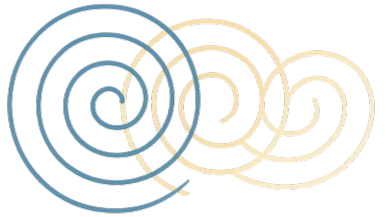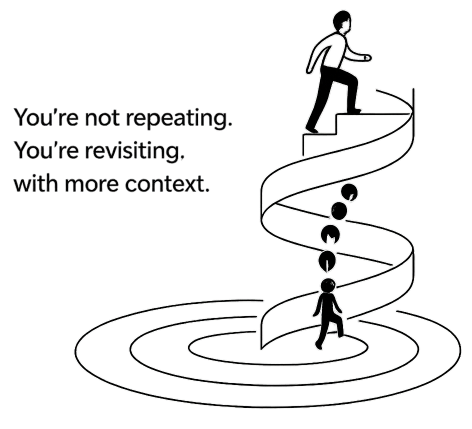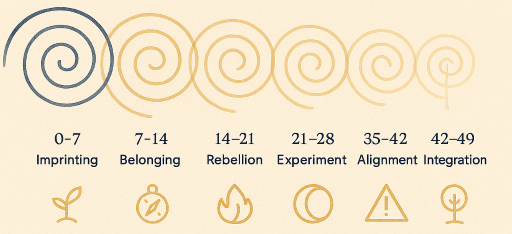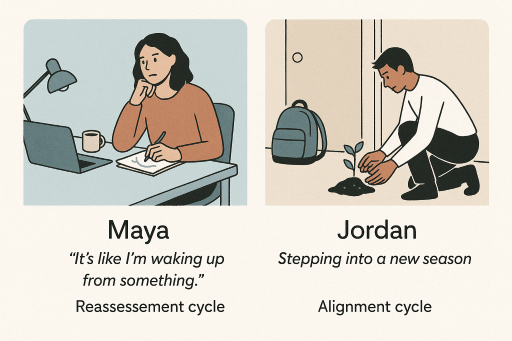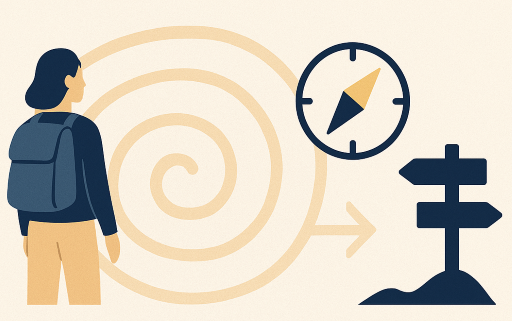The 7-Year Life Cycle: What’s Yours Right Now?
Have you ever looked back on your life and noticed a kind of rhythm? A pattern in when things seemed to fall apart—or come together?
Maybe it was around 28, when the career path you once felt sure about suddenly felt misaligned. Or 35, when your friendships shifted and you couldn’t ignore a growing sense of restlessness. Or 42, when the old ways of being no longer worked, but the new way hadn’t fully formed.
It’s not just you. These turning points aren’t random. They’re part of something deeply human: the 7-year life cycle.
We Don’t Grow in Straight Lines. We Grow in Waves.
Human development doesn’t happen in a neat, upward climb. It happens in spirals. In cycles. In distinct seasons of inner and outer change.
And while no framework can perfectly map the complexity of a human life, one pattern has shown up again and again — in everything from psychology to physiology to cultural lore: the 7-year rhythm.
Doctors note that the body’s cells renew roughly every 7–10 years. Developmental psychologists point to 7 as the age of cognitive independence. Philosophers and analysts like Rudolf Steiner and Carl Jung organized inner development into 7-year phases of individuation and integration.
Even in the workplace, it’s common to see career transitions or existential re-evaluations every 6–8 years — a subtle signal that something inside is outgrowing the current structure.
Whether we recognize it consciously or not, life seems to ask us to evolve every 7 years or so. Not necessarily in dramatic ways. But through a quiet pressure — a shift in questions, longings, and priorities. As if the terrain beneath our lives reshapes itself, inviting us to update our path.
Life as a Spiral Staircase
If you’ve ever felt like you're circling back to the same themes—only from a slightly higher vantage point—you’re not imagining it.
Life doesn’t move in straight lines. It spirals.
We revisit old lessons, relationships, and identities again and again — not because we’re failing to grow, but because we’re growing through them. Each return brings a new layer of insight. A new opportunity to respond differently.
Think of it like tree rings. Every 7 years, a new ring forms — shaped by the seasons it lived through. Each ring holds the memory of the cycle before it, but with more structure, more maturity, more nuance.
The 7-Year Psychological Seasons
Each 7-year phase tends to be anchored by a central question or life task. Not imposed, but emergent — shaped by our stage of development, context, and inner evolution.
These aren’t rigid boxes. But there are recurring themes:
From 0–7, we form our sense of safety and identity through imprinting.
From 7–14, we explore belonging, rules, and the beginnings of selfhood.
Between 14–21, it’s about rebellion, independence, and emotional fire.
Then comes 21–28 — trial and error, searching for meaning through experience.
From 28–35, we often seek alignment: What life am I really building?
Around 35–42, the questions shift again. Is this still me? What needs to change?
From 42–49, many enter a cycle of deeper integration — of stripping away what no longer fits, and rooting into a truer version of themselves.
Of course, timing varies. But the deeper logic holds: every 7 years or so, we’re asked to shed something, integrate something, and step into a more congruent version of ourselves.
These shifts can feel like breakdowns. But more often, they’re structural invitations. They ask us to re-pattern our choices, not because we failed — but because we’ve outgrown the architecture they were built on.
The Architecture of Inner Evolution
Here’s what most people miss: these transitions aren’t just emotional. They’re architectural.
Each cycle builds on the one before it — stacking new insights, identity shifts, and lessons into an evolving inner structure. When you zoom out, your life isn’t a scattered set of events. It’s a designed system — patterned, rhythmic, and intelligent in its unfolding.
Which brings us to the present.
So how do you know which cycle you are in — and what that means for the season of life you’re navigating right now?
Let’s take a closer look — not at a number on a timeline, but at the subtle shifts in your questions, your longings, your inner atmosphere.
Because if you’re around age 28, 35, or 42… you might already feel the undercurrent of change pulling at you.
That’s because you’ve entered a new psychological season.
Where Are You in the Cycle?
These life transitions aren’t random — they’re rhythmic. And while they don’t follow a fixed calendar, most of us feel them in waves every 6 to 8 years. The key isn’t to predict the exact moment of change — but to recognize the signals when they arise.
Start by asking yourself:
What part of my life feels like it’s outgrown its container?
What feels like it’s ending — even if nothing external has “ended” yet?
Where do I feel the urge to rebuild, redirect, or release?
These are the markers of a turning point.
Sometimes it feels like a tectonic shift. Other times, like a slow season change. Either way, something in you is being restructured.
Think of these shifts as spiral returns. You’re circling back to familiar themes — self-worth, purpose, connection — but from a higher level of awareness. You’re not repeating. You’re revisiting, with new tools and context.
Real Life, Real Cycles
Consider Maya, 35, a design director who has everything she once said she wanted: a good salary, a respected title, a steady life. But lately, she finds herself staring at her screen, uninspired. Meetings feel hollow. She’s begun sketching again in the evenings — not for work, but for herself.
She tells her friends, “It’s like I’m waking up from something.”
She’s not burned out. She’s entering a reassessment cycle — where her outer success no longer matches her inner truth. Her system is asking a deeper question now: “What do I really want to build next?”
Or take Jordan, 28. For years, he’s bounced between jobs and relationships, chasing freedom. But recently, he’s felt a pull toward structure — not out of pressure, but desire. He’s thinking about putting down roots, starting something meaningful. The chaos that once energized him now exhausts him.
He’s not “settling down.” He’s stepping into a new season: alignment and intentional adult identity.
These are the kinds of inflection points InnerMap helps decode.
Insight, Not Prediction
InnerMap isn’t here to tell you what’s going to happen. It’s not forecasting your future or labeling you by life stage.
What it does is help you recognize your current cycle — and give it language. It shows you whether you’re in a phase of expansion, integration, incubation, or release.
You’ll see where your patterns tend to repeat. What kind of energy is dominant now. What decisions might come with ease — and which ones might need more time.
We use visual frameworks like:
Spiral timelines – so you can see recurring themes from new perspectives
Turning points – subtle or obvious cues that signal it’s time to shift
Life phases – seasons of building, breaking down, or becoming
It’s not mystical. It’s structural. And once you can see the architecture of your season, your choices start to make more sense.
You’re Not Behind. You’re in Rhythm.
That’s the real insight: you’re not lost. You’re cycling.
And once you know where you are on the map, self-doubt gives way to discernment. You stop pushing when it’s time to pause. You stop waiting when it’s time to act. You begin to move with your life, not against it.
Because every 7-year shift isn’t a detour — it’s a doorway.
Curious what phase you’re in?
Get your personalized InnerMap report — and begin navigating your life with clarity, timing, and self-trust.


